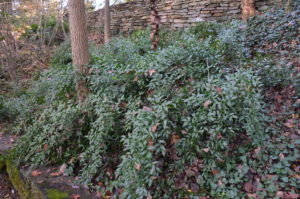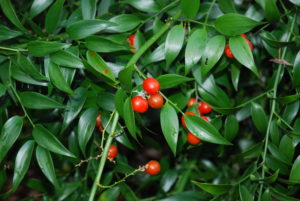Alexandrian Laurel or Poet’s Laurel (Danae racemosa) is a wonderful evergreen shrub that is rarely planted in U.S. gardens. Danae is indigenous to Iran and Syria. This evergreen shrub needs partial to full shade and the warm climes of southeast or Pacific northwest states (USDA hardiness zones 6 – 9). If winters are exceptionally cold in zone 6 (parts of Tennessee, Virginia and North Carolina), plants may freeze to the ground and re-sprout from underground rhizomes in late spring.
Danae grows 3 feet in height (4 to 5 feet wide) with lovely arching shoots. Its glossy green leaves are 3 to 4 inches long and 1.5-inch wide, arranged alternately along the branch. Small, inconspicuous yellow-green flowers appear in late spring from the leaf axils. In the fall orange-red berries in clusters. The brightly colored fruits (berries) are the truly outstanding asset of the plant. They persist through much of the winter.
Danae is a great woodland evergreen plant, growing in the deepest shade. It is demands a well-drained, moist, mildly acidic loamy soils. Danae is slow to establish and it should be watered if the dry periods last longer than 3 or 4 weeks. It is slow growing. The foliage will yellow and burn if exposed to direct sunlight. Shoots (canes) last 3 years; older gangly shrubs should be renovated every 3-4 years.
Plants may be propagated by division in early spring or from seeds collected in late fall and sown directly in a bed. You may have to wait two springs for most seedlings to emerge. The cut foliage is ideal for flower arrangements.
Historical perspective: Its common name is from Greek mythology – the foliage was used to adorn heroes scholars, poets and athletes. Statues depict honorees wearing a garland of leaves from the stems of this plant.



 Posted in
Posted in 
